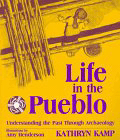
224 pages, $36.95 list
0-88133-964-4
978-0-88133-964-2
© 1998
paperback
Life in the Pueblo
Understanding the Past through Archaeology
Within the effective format of a nontechnical case study, Life in the Pueblo provides an understanding of the basic methodologies in modern archaeology, including the formation of archaeological sites, dating, the role of ethnographic analogy, and analytic techniques like trace element sourcing, use-wear analysis, and carbon isotope determinations of diet. The archaeological interpretations are put into perspective by the inclusion of Hopi and Zuni history and myth and the liberal use of ethnographic information from the Hopi and other historic and modern puebloan groups. A short fictional reconstruction of life in the village invites the student to reflect on the fact that the past was a period occupied by people, not just potsherds. Based on four years of excavation and ten years of analysis of a puebloan site near modern Flagstaff, Arizona, this profusely illustrated volume captures readers’ interest and imagination as it explores some of the fundamental principles of archaeology.
Reactions
“Life in the Pueblo is written in an easy, accessible style in spite of the technical discussion of archaeological methods. Her meshed narratives are generally skillfully woven and carefully explained so that the reader understands the source of each strand. Throughout the book, Kamp makes an effort to personalize not only the past but the profession of archaeology by naming those involved: her husband and codirector, John Whittaker, the students who undertook specific excavation or artifact analyses, and the specialists who worked with Lizard Man materials. [This book] will be warmly welcomed by the many nonprofessionals, especially in the Southwest, who are knowledgeable about and fascinated by archaeological methods and interpretations.” —American Anthropologist
1. Introduction
2. Uncovering the Past: Excavation
3. From Potsherds to People: Interpreting the Past
4. Charred Beams and Magnetic Particles: Dating the Site
5. Personalizing the Past
6. The People of Lizard Man Village
7. Rabbits and Corn: Sinagua Subsistence
8. The Artisans of Lizard Man Village
9. Families, Communities, and the Wider World
10. Egalitarian or Stratified: The Current Debate about Social Organization
11. Lizard Man Village—Abandoned, But Not Forgotten
2. Uncovering the Past: Excavation
3. From Potsherds to People: Interpreting the Past
4. Charred Beams and Magnetic Particles: Dating the Site
5. Personalizing the Past
6. The People of Lizard Man Village
7. Rabbits and Corn: Sinagua Subsistence
8. The Artisans of Lizard Man Village
9. Families, Communities, and the Wider World
10. Egalitarian or Stratified: The Current Debate about Social Organization
11. Lizard Man Village—Abandoned, But Not Forgotten